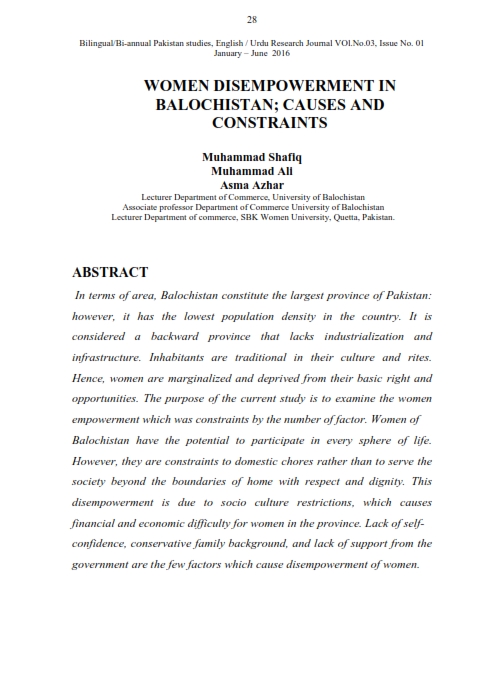WOMEN DISEMPOWERMENT IN BALOCHISTAN; CAUSES AND CONSTRAINTS
Keywords:
Women empowerment, Causes, Constraints in Quetta.Abstract
In terms of area, Balochistan constitute the largest province of Pakistan:
however, it has the lowest population density in the country. It is
considered a backward province that lacks industrialization and
infrastructure. Inhabitants are traditional in their culture and rites.
Hence, women are marginalized and deprived from their basic right and
opportunities. The purpose of the current study is to examine the women
empowerment which was constraints by the number of factor. Women of
Balochistan have the potential to participate in every sphere of life.
However, they are constraints to domestic chores rather than to serve the
society beyond the boundaries of home with respect and dignity. This
disempowerment is due to socio culture restrictions, which causes
financial and economic difficulty for women in the province. Lack of selfconfidence, conservative family background, and lack of support from the
government are the few factors which cause disempowerment of women.
Women are supposed to be remained within the boundaries of house.
Generally, they have no such permission to access the outside without the
consent of their male member. As a matter of fact, they are not permitted
to contribute in the earning of household by approaching outside the home
side. In many cases, women are allowed for selective job opportunities
which entirely depends on the male member mental approach. The
willingness of women to choose their life partner is almost impossible
or/and considered taboo. Early marriages are also rampant in rural areas
of the province. Women are constraints to get education. Most of areas in
Balochistan, girls are marginalize from schooling. Lack of self-belief and
confidence, financial difficulties, unawareness of laws are the few other
causes which disempowered the women in the province. This paper is an
attempt to measure the causes of disempowerment. Convenience sampling
technique was used to collect the data using five scale Likert scale selfconstructed questionnaire with proper steps taken to ensure reliability and
validity of measurement. Hypotheses were tested using correlation and
hierarchical moderated regression analysis. Results indicated that there is
a constraints for women for her economic growth and development,
causing disempowerment for women
References
Addis,David (2005) Document UNFPA Gender inequality and
women empowerment pp: 34
• Austin Urick (2004). The Solemn Declaration on Gender Equality
in Africa (SDGEA), Addis Ababa, Ethiopia.
• CEDAW (1999). Convention for Elimination of All Forms of
Discrimination against Women Articles.
• Deepti Umashankar (2006) dissertation on Indian institute of
management Bangalore
• Esther Duflo (December 2011) Women’s Empowerment and
Economic Development NBER Working Paper No. 17702 JEL
No.D1, O1,O12
• Farooq Muhammad (2003) dissertation Structural transformation
and gender empowerment in Pakistan
• Gaidzwanwa, Robert. (1992). “Bourgeois Theories of Gender and
Feminism and their Shortcomings with Reference to Southern
African Countries”, in Meena, R. (ed.) Gender in Southern Africa:
• Conceptual and Theoretical Issues, Harare, Sape Books.
• John Coonrod (Year 2011) Article in Monday Developments
Magazine Women and Poverty: New Challenges.
• Kabeer, Naila (1998) Re-evaluating Gender, Credit and
empowerment in rural Bangladesh IDS Discussion paper
• Kabeer, Naila (2000). The power to choose: Bangladeshi women
and labour market decisions in London and Dhaka. London New
York: Verso Books. ISBN 9781859848043.
• Kabeer, Naila 2011 “Reflections on the measurement of women
empowerment”. In discussing women empowerment-Theory and
practice
• Karen Oppenheim mason & Herbert L. smith (2 January 2003)
University of Pennsylvania Philadelphia, USA. The World Bank
Washington DC
• Longwe, S.H. (2002). Assessment of the Gender Orientation of
NEPAD, Paper Presented at the African Forum for Envisioning
Africa, Nairobi, Kenya, 26th – 29th, April 2002.
• Narayan, D. (2005). “Conceptual Framework and Methodological
Challenges”, in Narayan, D. (ed.) Measuring Empowerment: Cross
Disciplinary Perspectives, Washington D.C., IBRD/the World
Bank
• Oyewumi, Oliver. (2004). “Conceptualizing Gender: Eurocentric
Foundations of Feminist Concepts and the Challenge of African
Epistemologies”, African Gender Scholarship: Concepts,
Methodologies and Paradigms, Gender Series 1, Dakar,
CODESRIA
• Rubina Saigol (January 2011) A scoping study Women’s
empowerment in Pakistan
• Sen Gita (1993) Women’s Empowerment and human rights; the
challenge to policy paper presented to the Population Summit of
the Worlds scientific academies.
• UNESCO (2007). Education for Girls: Gender Parity Challenge of
Education for All Goals. Women of the World Report (2004).
Adeniran, A. (2006). “A Non-Dependent Framework for
Development”, Thisday, Wednesday, August 23, 2006.



